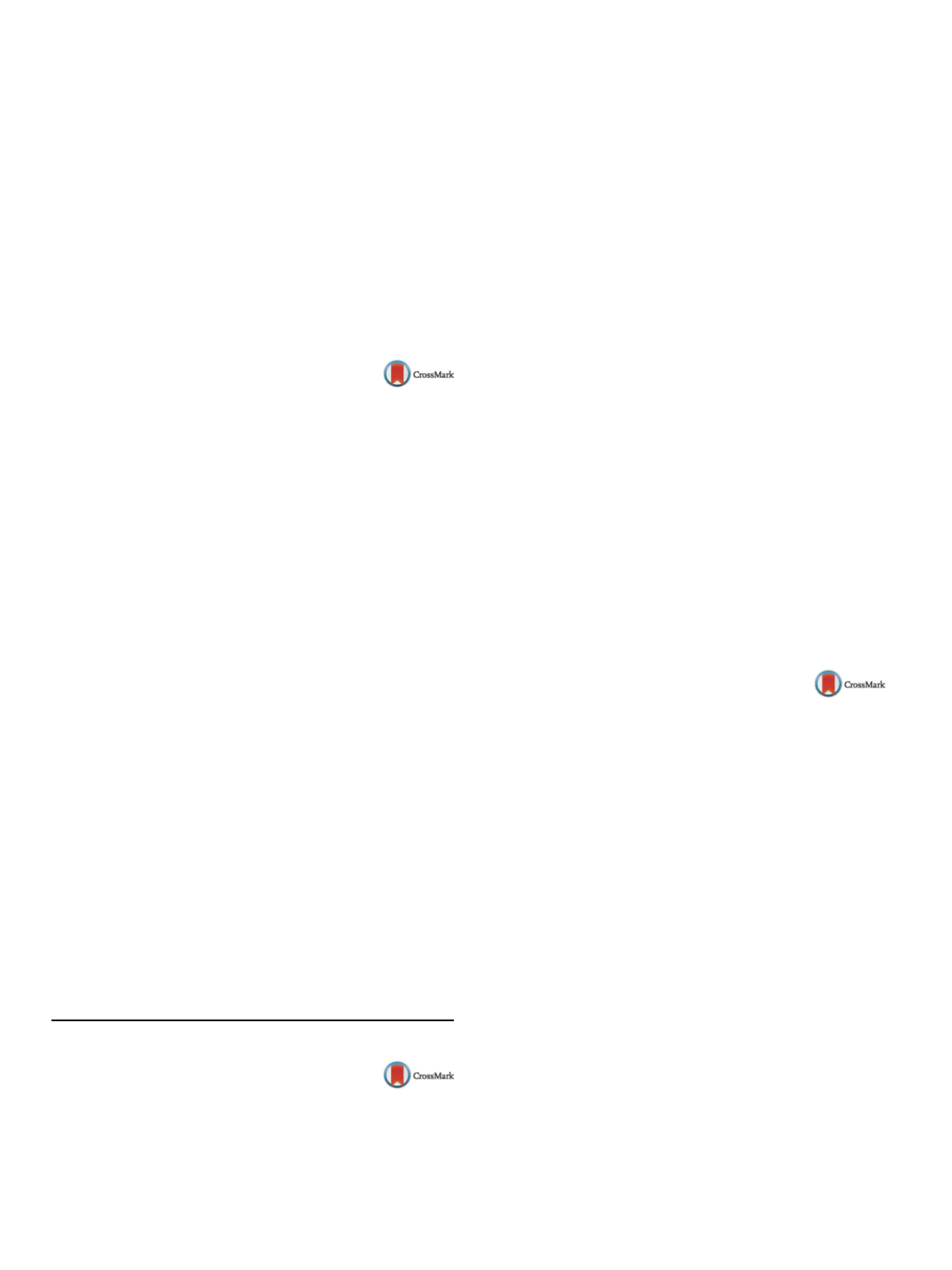

S418
25th European Congress of Psychiatry / European Psychiatry 41S (2017) S405–S464
features of anxiety, seizing, high emotivity. The maximum val-
ues for the scales of anxiety (ANX, PHOB) recorded in patients
with somatoform dysfunction of the autonomic nervous system
(SDANS). Evaluation of coping strategies showed a preferential use
of the “avoidance” strategy by patients with SD, USD, a rare use of
social support strategies, responsibility. Patients with somatoform
pain disorder often resorted to seek social support.
Conclusion
The use of the questionnaire SCL-90-r has identified
a number of clinical features of patients with different variants of
the SFD. Typologically in all samples of patients revealed moderate
accentuation on emotivity trait.
Disclosure of interest
The authors have not supplied their decla-
ration of competing interest.
http://dx.doi.org/10.1016/j.eurpsy.2017.01.371EV0043
Acupuncture decreases competitive
anxiety prior to a competition in
young athletes: A randomized
controlled trial study
S. Zarei Serkani
∗
, M. Shayestefar , A.H. Memari
Sports Medicine Research Center, Neuroscience Institute, Tehran
University of Medical Science, Department of Sports Medicine,
Tehran, Iran
∗
Corresponding author.
Introduction
Although a certain level of competitive anxiety
may increase performance, many athletes with anxiety experience
uncontrolled negative feelings and cognition that in turn can have
overwhelming effects on their performance.
Objectives
Indeed, we aimed to assess the effect of the acupunc-
ture on competitive anxiety in a sample of young football players
using physiological biomarkers and subjective anxiety measures.
Methods
We aimed to assess the effect of acupuncture on com-
petitive anxiety of the adolescent football players prior to the
competition using psychological and physiological markers. A total
of 30 athletes were randomly and equally allocated to either
acupuncture or sham control group.
Results
The results of
t
-test on posttest scores showed that
acupuncture had a significant effect on cognitive anxiety (
P
= 0.001)
and somatic anxiety (
P
< 0.001) but not self-confidence (
P
> 0.05).
Furthermore, the results showed that acupuncture significantly
decreased the skin conductance in acupuncture group compared
to sham group (
P
= 0.006) (
P
< 0.001).
Conclusions
In conclusion, the results suggested that acupunc-
ture have the capacity to decrease cognitive and somatic anxiety
prior to competition in adolescent athletes while this was accom-
panied by significant physiological changes.
Disclosure of interest
The authors have not supplied their decla-
ration of competing interest.
http://dx.doi.org/10.1016/j.eurpsy.2017.01.372e-Poster viewing: bipolar disorders
EV0044
Mental health literacy in bipolar
disorder: A cross-sectional survey in
Saudi Arabia
F. Alosaimi
1, D. Alateeq
1 ,∗
, R. AlHenaki
2, S. Bin Hussain
2,
A. Bin Salamah
2, A. Al-Muhanna
2, M. AlAngari
21
King Saud University, Department of Psychiatry, Riyadh, Saudi
Arabia
2
King Saud University, College of Medicine, Riyadh, Saudi Arabia
∗
Corresponding author.
Introduction
Stigmatization of individuals with mental illnesses
is widespread and serves as a major barrier to treatment. Spe-
cific alterations in mental health literacy about a disorder and its
perceived treatability can change this social attitude. Assessing
awareness of bipolar disorder is important as the WHO ranked
bipolar disorder as the sixth cause of disability.
Objectives
To assess mental health literacy (knowledge, attitudes
and beliefs) in bipolar disorder among Saudi population.
Methods
Cross sectional study is currently conducted. We are
using valid reliable questionnaire assessing the level of awareness,
knowledge, attitude and behavior toward bipolar disorder. It is dis-
tributed to adult Saudi citizen (> 17 years of age) inmalls, university
and hospitals in Riyadh. People who are known to have psychiatric
disorder and their caregivers or who works as psychiatrists and
psychologists are excluded.
Results
There are 200 samples collected, and 14 were excluded
according to exclusion criteria. Fifty-two percent of our prelimi-
nary sample has heard about bipolar disorder, and more than half
of them believe that neurotransmitter disturbances, substance use
and psychological trauma are more likely to be causes of bipolar. In
contrast, 49% of the sample did not choose psychiatric medication
as effective treatment for bipolar, whereas more than half of them
chose praying.
Conclusions
It is a first-of-its-kind research study in Saudi Arabia
determining the current mental health literacy of bipolar disor-
der in Saudi Arabia. We are aiming to increase the sample size to
reach 1000 participants. Further studywill be needed to investigate
possible interventions to improve such problem.
Disclosure of interest
The authors have not supplied their decla-
ration of competing interest.
http://dx.doi.org/10.1016/j.eurpsy.2017.01.373EV0045
Demyelination in rat model of
mania-like behavior
M. Andrabi
1 ,∗
, V. Subbiah
1, R. Sagar
2, R. Mathur
31
AIIMS, Neurobiochemistry, New Delhi, India
2
AIIMS, Psychiatry, New Delhi, India
3
AIIMS, Physiology, New Delhi, India
∗
Corresponding author.
Introduction
Ample amount of data suggests role of REM sleep
deprivation as the cause and effect of mania. In the present model,
we have tried to implement behavioral sensitization to sleep
deprivation, conditions mimicking natural circumstances, so as to
produce an animal model with symptomatology resembling very
close to human mania. Pre-clinical and clinical studies have shown
that mania is often co-morbid with multiple sclerosis, therefore
we sought to find out whether myelin integrity is disrupted and if
lithium could protect against such damage.
Objectives
(1) To analyse mania-like behavior after REM sleep
deprivation. (2) To analyse any damage to myelin under TEM.
Aims
We wanted to see if there could be any damage to myelin
after behavioral sensitization to stress.
Methods
Rats were sleep deprived by classical flowerpot or plat-
form method. OFT was performed to assess behavior of rats. The
analysis was performed over 5min, separated into 5 bins of 1min
each. Behavioral scores included total square entries, inner square
entries, time spent in center, rearing frequency, time spent rearing,
number of grooming bouts, time spent grooming defecation and
time spent still. TEM was performed to study changes in myelina-
tion in two distinct regions of brain, DG and VTA.
Results
It was observed that the REM sleep deprived rats had
mania like symptoms. REM sleep deprivation lead to demyelina-
tion in DG and VTA. Lithium treatment restored myelination per
se.


















